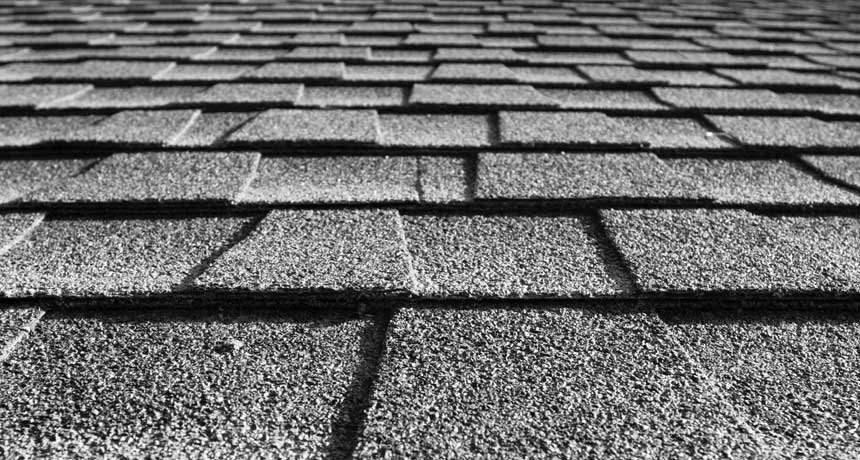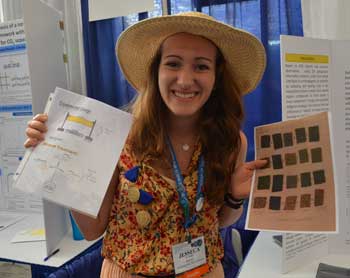Keeping roofs cooler to cut energy costs
A simple paint-on coating might cut home energy use and urban pollution, a teen’s research suggests

Asphalt roofing shingles, especially dark ones like those shown here, can get scorching hot on summer days. Then they'll also shed some of that heat into buildings. A new coating can help shingles reflect more of the sunlight that heats them up. And that could cut home cooling bills.
christophriddle/iStockphoto
By Sid Perkins
PITTSBURGH, Pa. — The roof of a house can get pretty hot in the summer. Even if there is an insulated attic below, some of that heat can work its way into the living space. That can make air conditioners work harder and pump up electricity bills. But a thin, paint-like coating could help keep roofs cooler, a teen researcher finds. And in urban areas, widespread use of her new roofing treatment might even cut the formation of lung-irritating ozone on hot days.
Shingles come in many colors, but dark ones are especially popular, says Jesseca Kusher. The 18-year old attends Spartanburg Day School in South Carolina. Like most dark objects, shingles absorb a lot of heat from sunlight. In the summer sun, they can easily reach 73.5° Celsius (164° Fahrenheit), she notes. If those shingles reflected more sunlight, they’d stay cooler. And that could help cut down on home cooling bills. According to the Environmental Protection Agency, air conditioning consumes about 5 percent of all the energy used in the United States. Cooling buildings costs the nation about $11 billion each year.

Each of these powders came in several colors. In each of Jesseca’s test recipes, her reflective powder accounted for 40 percent of the weight of the final mixture. She also prepared some of the paint-like coatings with no additive. That would let her judge whether a powder — versus the transparent goop it was added to — affected a shingle’s reflectivity, she explains.
Jesseca used four different colored shingles. She painted each of her concoctions onto bits of each color of shingle and let them dry for 24 hours. Then, to simulate how the shingles would heat up in summer, she placed each postage-stamp-size sample under a 150-watt sun lamp. (Those bulbs send out radiation across a wide band of wavelengths, similar to those emitted by the sun.) Each test sample was irradiated for 15 minutes, or until the untreated shingles reached a temperature of 73.5 °C, whichever came first. To measure how hot each sample got, the teen used an instrument that measures the infrared radiation (heat) emitted by an object.
Plain, unpainted shingles got hotter than shingles coated with paints that contained one of the powder additives. The samples that had a coating without any powder got just as hot as the unpainted shingles. That’s a sure sign that the powders were responsible for any cooling effect, Jesseca concludes.
The glittery mica had the best overall cooling effect. Shingles with this coating only heated up, on average, to about 58.5 °C (about 137 °F). Shingles coated with gypsum or powdered graphite got a bit warmer, to between 57 and 63 °C (up to 145 °F).
The results for graphite were a huge surprise, says Jesseca. This coating left shingles darker than the untreated ones. According to conventional thinking, they therefore should have soaked up more heat, she says. But the powdered graphite must be reflecting more infrared radiation, she now suspects.
Jesseca provided details of her research at the 2015 Intel International Science and Engineering Fair. This event was created by the Society for Science and the Public (which also publishes Science News for Students) and is sponsored by Intel. The annual competition brought 1,702 finalists to Pittsburgh this year. They came from more than 70 countries.
Besides trimming cooling bills, the new coatings also could keep urban air cooler, says Jesseca. As cities grow, they usually get warmer than rural regions nearby. Pavements and other building surfaces tend to soak up sunshine and get hotter. Then they release that heat into the air, especially at night. Cars and machines such as air conditioners also release heat. Altogether, these things create what scientists call an “urban heat island” effect. This effect can raise city temperatures by 0.5 °C (0.9 °F) or more compared to areas that are grassy or lack a lot of buildings.
That extra heat inside cities can speed up chemical reactions in the air. Some of these reactions can create ozone, which can irritate the eyes and lungs. Cooling off a lot of roofs could decrease ozone production, Jesseca reasons.
There are a lot of roofs in the United States, so there’s plenty of opportunity to cut down on electricity bills and ozone production, she says. According to one study, scientists calculated that roofs cover about 172.4 billion square feet of the U.S. area. That’s an area bigger than the entire state of Connecticut!
Power Words
(for more about Power Words, click here)
graphite Like diamond, graphite — the substance found in pencil lead — is a form of pure carbon. Unlike diamond, graphite is very soft. The main difference between these two forms of carbon is the number and type of chemical bonds between carbon atoms in each substance.
gypsum A common mineral often used as fertilizer, as chalk and in plaster. It is commonly found in the drywall used to construct interior walls and ceilings.
infrared light A type of electromagnetic radiation invisible to the human eye. The name incorporates a Latin term and means “below red.” Infrared light has wavelengths longer than those visible to humans. Other invisible wavelengths include X rays, radio waves and microwaves. Infrared light tends to record the heat coming off of an object or the environment.
irradiate To beam some light or other form of radiation onto a surface.
mica A family of minerals, many of which readily break into small, glittering flakes.
mineral The crystal-forming substances, such as quartz, apatite, or various carbonates, that make up rock. Most rocks contain several different minerals mixed together. A mineral usually is solid and stable at room temperatures and has a specific formula, or recipe (with atoms occurring in certain proportions) and a specific crystalline structure (meaning that its atoms are organized in certain regular three-dimensional patterns).
ozone A colorless gas that forms high in the atmosphere and at ground level. When it forms at Earth’s surface, ozone is a pollutant that irritates eyes and lungs.
radiation (in physics) One of the three major ways that energy is transferred. (The other two are conduction and convection.) In radiation, electromagnetic waves carry energy from one place to another. Unlike conduction and convection, which need material to help transfer the energy, radiation can transfer energy across empty space.
Society for Science and the Public (or SSP) A nonprofit organization created in 1921 and based in Washington, D.C. Since its founding, SSP has been not only promoting public engagement in scientific research but also the public understanding of science. It created and continues to run three renowned science competitions, including the Intel International Science and Engineering Fair (initially launched in 1950). SSP also publishes award-winning journalism in Science News (launched in 1922) and Science News for Students (created in 2003).
urban heat island A city or metropolitan area that’s significantly warmer than surrounding rural landscapes. The increased temperature results from several phenomena. Many hard surfaces, such as buildings and pavements, absorb sunlight and then release that energy — as heat — into the air. Also, human activities such as running air conditioners and driving cars will release large amounts of heat directly into the environment.
wavelength The distance between one peak and the next in a series of waves, or the distance between one trough and the next. Visible light — which, like all electromagnetic radiation, travels in waves — includes wavelengths between about 380 nanometers (violet) and about 740 nanometers (red). Radiation with wavelengths shorter than visible light includes gamma rays, X-rays and ultraviolet light. Longer-wavelength radiation includes infrared light, microwaves and radio waves.







